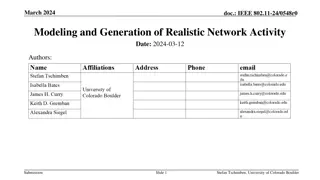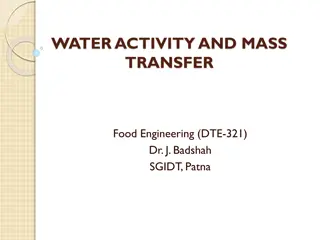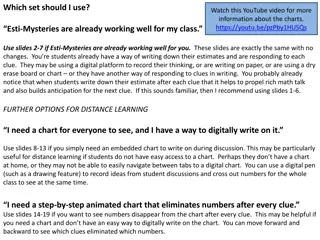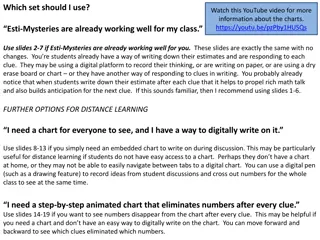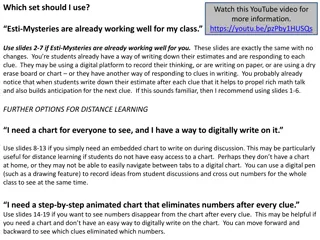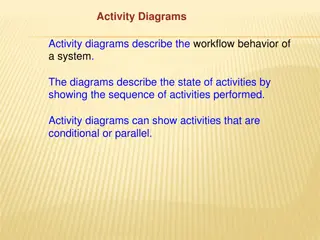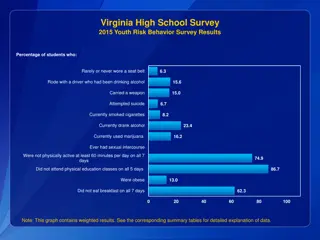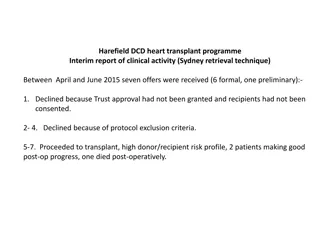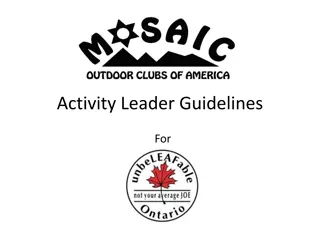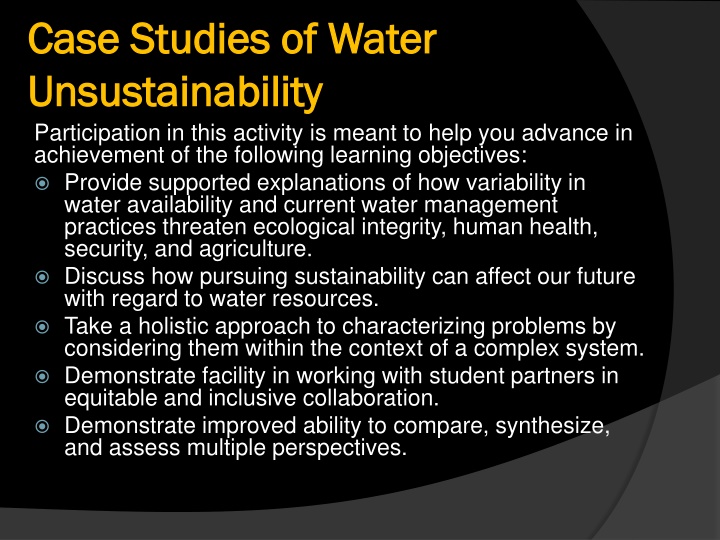
Water Resource Problems and Drivers of Unsustainability
Explore the challenges related to water resource management and sustainability, including the impact on ecological integrity, human health, security, and agriculture. Learn about the various drivers contributing to water security threats and how they affect different aspects of the ecosystem. Gain insights into the importance of agricultural practices in shaping water resource issues and the implications for future sustainability.
Download Presentation

Please find below an Image/Link to download the presentation.
The content on the website is provided AS IS for your information and personal use only. It may not be sold, licensed, or shared on other websites without obtaining consent from the author. If you encounter any issues during the download, it is possible that the publisher has removed the file from their server.
You are allowed to download the files provided on this website for personal or commercial use, subject to the condition that they are used lawfully. All files are the property of their respective owners.
The content on the website is provided AS IS for your information and personal use only. It may not be sold, licensed, or shared on other websites without obtaining consent from the author.
E N D
Presentation Transcript
Case Studies of Water Case Studies of Water Unsustainability Unsustainability Participation in this activity is meant to help you advance in achievement of the following learning objectives: Provide supported explanations of how variability in water availability and current water management practices threaten ecological integrity, human health, security, and agriculture. Discuss how pursuing sustainability can affect our future with regard to water resources. Take a holistic approach to characterizing problems by considering them within the context of a complex system. Demonstrate facility in working with student partners in equitable and inclusive collaboration. Demonstrate improved ability to compare, synthesize, and assess multiple perspectives.
Get in Reading Groups Share your insights on your reading. What are the primary water resource problems discussed? Break it down 1. What are the competing needs? 2. How is agriculture an important part of the story? 3. What negative impacts were outlined? 4. What were the drivers of the problems? 5. You may want to refer to the following models
The Drivers that Contribute to The Drivers that Contribute to Water Security Threat Water Security Threat Driver Contributions to Water Security Threats 50 Relative Contribution (%) 45 40 Human Security 35 30 25 Biodiversity 20 15 10 5 0 Watershed Disturbance Pollution Water Resource Development Biotic Factors What do they mean by drivers?
The Drivers that Contribute to The Drivers that Contribute to Water Security Threat Water Security Threat Water Resource Development 3000 Human Security Aggregate Score in Modeling 2500 Biodiversity 2000 1500 1000 500 0 Dam Density River Consumptive Water Loss Human Water Stress Agricultural Water Stress Flow Fragmentation Disruption Note how the relative importance of the driver depends on whether the threat is to people or other organisms
The Drivers that Contribute to The Drivers that Contribute to Water Security Threat Water Security Threat Watershed Disturbance Biotic Factors Aggregate Score in Modeling 3500 3500 Aggregate Score in Modeling 3000 3000 2500 2500 2000 2000 1500 1500 1000 1000 500 500 0 0 Cropland Impervious Surfaces Livestock Density Wetland Disconnectivity Non-native Fishes Fishing Pressure Aquaculture Pressure Human Security Biodiversity Consider the collective impact of how we feed ourselves.
The Drivers that Contribute to The Drivers that Contribute to Water Security Threat Water Security Threat Pollution 2000 Aggregate Score in Modeling Human Security 1500 Biodiversity 1000 500 0 Soil Nitrogen Loading Phosphorous Loading Mecury Deposition Pesticide Loading Sediment Loading Organic Loading Potential Acidification Thermal Alteration Salinization Are there other important drivers not included in these slides?
Relating your Reading to Relating your Reading to Sustainability Sustainability How do the actions outlined in your case study fail to meet the criteria for water sustainability as detailed in the reading by Gleick et al., (1995)? Can you use this article to evaluate the sustainability of water use in the region(s) discussed in your article?
A Take A Take on Water Sustainability on Water Sustainability The use of water that supports the ability of human society to endure and flourish into the indefinite future without undermining the integrity of the hydrological cycle or the ecological systems that depend on it.
In what ways are the actions discussed in your reading failing to meet the following criteria? Sustainability Criteria for Water 1. A minimum water requirement will be guaranteed to all humans to maintain human health. 2. Sufficient water will be guaranteed to restore and maintain the health of ecosystems. Specific amounts will vary depending on climatic and other conditions. Setting these amounts will require flexible and dynamic management. 3. Data on water resources availability, use, and quality will be collected and made accessible to all parties. 4. Water quality will be maintained to meet certain minimum standards. These standards will vary depending on location and how the water is to be used. 5. Human actions will not impair the long-term renewability of freshwater stocks and flows. 6. Institutional mechanisms will be set up to prevent and resolve conflicts over water. 7. Water planning and decision-making will be democratic, ensuring representation of all affected parties and fostering direct participation of affected interests.
In which of these ways are the actions discussed in your reading most failing to meet the following criteria? Prioritize. Prioritize. Sustainability Criteria for Water 1. A minimum water requirement will be guaranteed to all humans to maintain human health. 2. Sufficient water will be guaranteed to restore and maintain the health of ecosystems. Specific amounts will vary depending on climatic and other conditions. Setting these amounts will require flexible and dynamic management. 3. Data on water resources availability, use, and quality will be collected and made accessible to all parties. 4. Water quality will be maintained to meet certain minimum standards. These standards will vary depending on location and how the water is to be used. 5. Human actions will not impair the long-term renewability of freshwater stocks and flows. 6. Institutional mechanisms will be set up to prevent and resolve conflicts over water. 7. Water planning and decision-making will be democratic, ensuring representation of all affected parties and fostering direct participation of affected interests.
In the situations you read about, do you think it is possible to meet all of the following criteria? Sustainability Criteria for Water 1. A minimum water requirement will be guaranteed to all humans to maintain human health. 2. Sufficient water will be guaranteed to restore and maintain the health of ecosystems. Specific amounts will vary depending on climatic and other conditions. Setting these amounts will require flexible and dynamic management. 3. Data on water resources availability, use, and quality will be collected and made accessible to all parties. 4. Water quality will be maintained to meet certain minimum standards. These standards will vary depending on location and how the water is to be used. 5. Human actions will not impair the long-term renewability of freshwater stocks and flows. 6. Institutional mechanisms will be set up to prevent and resolve conflicts over water. 7. Water planning and decision-making will be democratic, ensuring representation of all affected parties and fostering direct participation of affected interests.
Be prepared to share your analysis of your reading with other students But first take a 5 minute break Get into new groups, where there is a representative for each reading
Share and Compare Pt. 1 Lightning round! Each person take <2 minutes to highlight what your reading was about and the primary problems. After everyone in the group has a grasp of the regional water problems discussed in the readings, then Take turns sharing the results of your first group s collective analyses, specifically
Share and Compare Pt. 2 1. What are the competing needs? 2. How is agriculture an important part of the story? 3. What negative impacts were outlined? 4. What were the drivers of the problems? 5. In what ways are the actions discussed in your reading failing to meet the Gleick s sustainability criteria? 6. In which of these ways are the actions discussed in your reading most failing to meet the following criteria?
Cross-Case Study Meta-Analysis What do these various case studies have in common? What problems what unsustainable actions/decisions are cropping up again and again? What are the opportunities for more sustainable water use in agriculture? Report Out, Class Discussion





